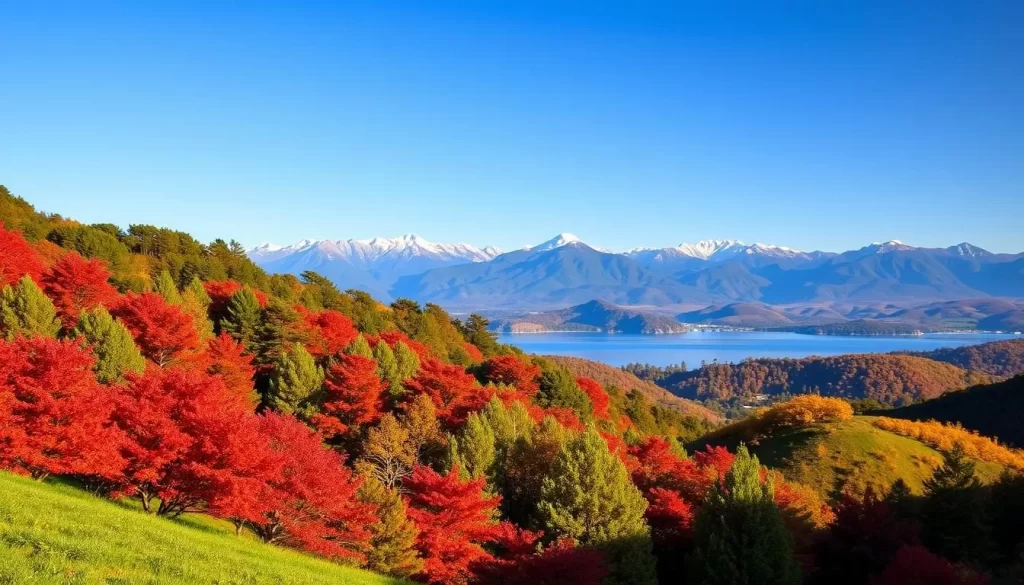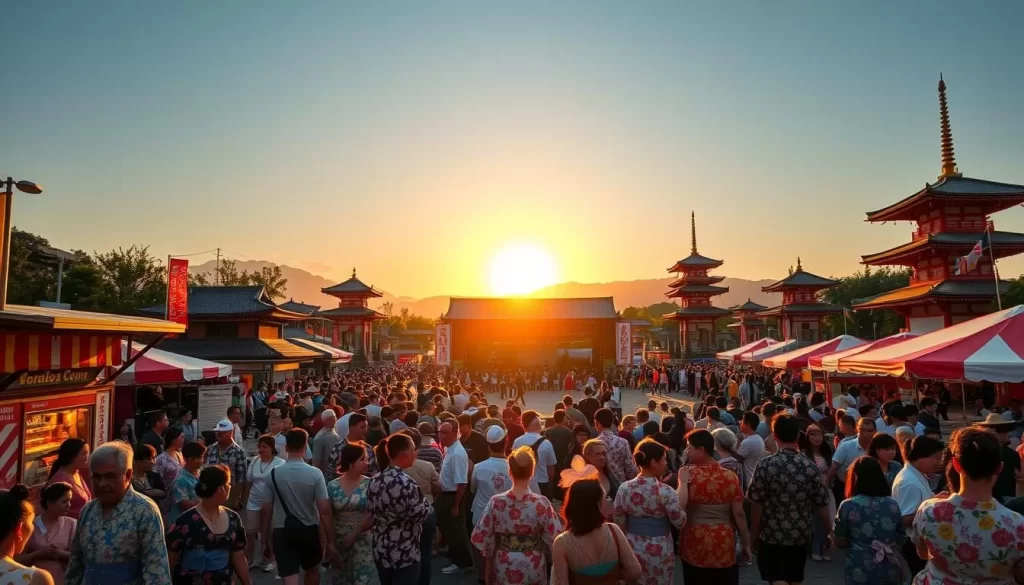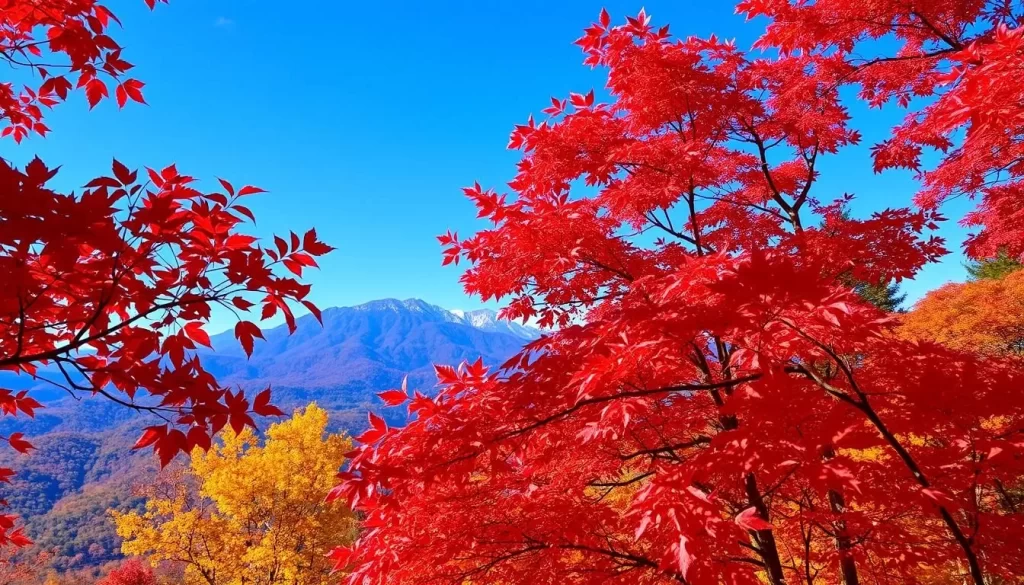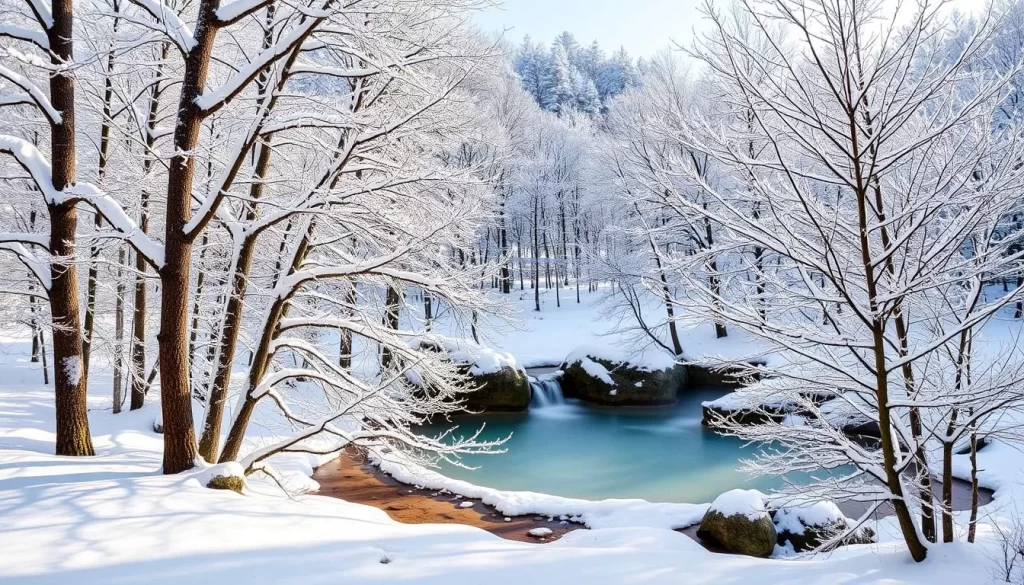✓ Accommodations✓ Flights✓ Rental Cars
When planning a trip to Gunma Prefecture, understanding its unique climate patterns is crucial due to its mountainous topography.
The weather in Gunma varies significantly across different areas, with the hottest months being July to September and the coldest from December to March.
To make the most of your trip, it’s essential to identify the best months to visit based on your weather preferences and the activities you’re interested in.
From hot summers to snowy winters, Gunma’s distinct seasons offer a range of experiences, including cherry blossoms in spring and vibrant autumn foliage.
Understanding Gunma Prefecture’s Climate
Understanding the climate of Gunma Prefecture is essential for planning a weather-savvy trip. Gunma Prefecture experiences a temperate climate with four distinct seasons, each offering unique experiences for visitors.

Geographical Influences on Weather Patterns
The diverse geography of Gunma Prefecture significantly influences its climate, resulting in varied weather conditions. The prefecture’s mountainous areas generally receive more precipitation than the lowlands, with some northern regions experiencing heavy snowfall in winter.
Temperature Variations Between Regions
Temperature variations between regions in Gunma Prefecture are notable. The hottest months are July to September, and the coldest are December to March. These variations are largely due to the prefecture’s geography, with mountainous areas tend to be cooler than the lowlands.
Annual Precipitation and Humidity Levels
Gunma Prefecture experiences distinct precipitation patterns throughout the year. The rainy season typically occurs from early June to mid-July, characterized by increased humidity and overcast conditions. Summer months (July to September) combine high temperatures with elevated humidity levels, creating hot humid conditions. In contrast, the autumn months offer relief with decreasing humidity and more comfortable conditions.
By understanding these climate patterns, you can better plan your trip to Gunma Prefecture and make the most of your visit.
Spring in Gunma: Cherry Blossoms and Mild Weather
As the winter chill dissipates, Gunma Prefecture transforms into a vibrant spring paradise, making it an ideal time to visit. The season brings with it a plethora of experiences that showcase the natural beauty and cultural richness of the region.
March to May Weather Overview
Spring in Gunma, spanning from March to May, is characterized by mild temperatures, making it a great time to explore the outdoors. The weather gradually warms up, with average highs rising from 12°C in March to 23°C in May, creating perfect conditions for various outdoor activities.
Cherry Blossom Season Highlights
The cherry blossom season is a highlight of spring in Gunma, with many parks and locations offering traditional hanami (cherry blossom viewing) experiences. You can enjoy the beauty of cherry blossoms in full bloom, typically around late March to early April, making it a time visit Japan for many travelers.
Popular spots for cherry blossom viewing include various parks throughout the prefecture, where locals gather to appreciate the beauty of nature and enjoy food and drinks under the blooming trees.
Spring Festivals and Activities
Spring in Gunma is not just about the cherry blossoms; it’s also a season of various festivals and activities. The Takasaki Daruma Festival in early April is a notable event, showcasing daruma doll markets and traditional performances. Additionally, the Azalea Festival at Akagi Shrine in May presents thousands of colorful azaleas in bloom, creating a stunning follow-up to the cherry blossom season.
You can also explore historic sites like the UNESCO World Heritage Tomioka Silk Mill, where spring gardens add to the historic atmosphere. Moreover, hiking trails throughout Gunma’s mountains reopen in spring, offering spectacular views of blooming mountainsides and valleys, making it a great time to visit Japan.
Summer Adventures: Navigating the Heat and Humidity
Despite the hot weather, summer is a great time to visit Gunma, with many opportunities to enjoy the outdoors, experience local culture, and relax in the prefecture’s famous hot springs.
June to August Temperature Patterns
Summer in Gunma is characterized by hot and humid conditions, with temperatures often reaching their peak in July and August. During this time, the average high temperature is around 30°C (86°F), making it essential to stay hydrated and take breaks in shaded areas.
Rainy Season Considerations
Although summer is generally warm and sunny, Gunma experiences a rainy season in June and July, known as “tsuyu” or “baiyu.” This period of increased rainfall is crucial for the region’s agriculture, but it can also impact outdoor activities. Visitors should be prepared for occasional rain showers and plan accordingly.
Summer Outdoor Activities and Festivals
Summer in Gunma offers a wide range of exciting outdoor activities and cultural experiences. You can enjoy water sports and activities at Lake Haruna and the Tone River, such as kayaking, rafting, and canyoning, which provide refreshing ways to beat the heat. The region is also known for its vibrant summer festivals (matsuri), featuring traditional dances, music, food stalls, and spectacular fireworks displays.
The Takasaki Fireworks Festival in August is one of the region’s largest, with thousands of colorful fireworks illuminating the night sky. Additionally, hiking in Gunma’s higher elevation areas remains pleasant during summer, with trails on Mount Akagi and Mount Haruna offering cooler temperatures and beautiful scenery.

Summer is also the perfect season to experience Gunma’s famous outdoor hot springs with mountain views, particularly in the evening when temperatures are more comfortable. However, be aware that tourist attractions may be busier during the Japanese school holiday period from late July through August, especially on weekends and during festival days.
Autumn in Gunma: Foliage and Comfortable Temperatures
Autumn brings a kaleidoscope of colors to Gunma, creating a picturesque backdrop for your travels. This season offers a unique blend of natural beauty and cultural experiences that make it an attractive time to visit.

September to November Weather Conditions
From September to November, Gunma experiences mild and relatively dry weather, making it an ideal time to explore the prefecture. The temperatures are comfortable, ranging from cool mornings to warm afternoons, perfect for outdoor activities like hiking and sightseeing.
Prime Locations for Fall Foliage Viewing
Gunma is home to numerous spots that offer breathtaking views of autumn foliage. Some of the prime locations include the mountains of Nikko National Park, the gardens of the Gunma Prefectural Museum of History, and the scenic routes along the Agatsuma River. These areas are adorned with vibrant colors, creating a stunning landscape.
Autumn Cultural Experiences and Events
Autumn in Gunma is not just about the foliage; it’s also a season rich in cultural experiences. You can participate in the Takasaki Daruma Market, enjoy special autumn concerts by the Gunma Symphony Orchestra, and sample local specialties during harvest festivals. Traditional moon-viewing parties (tsukimi) in September offer a glimpse into centuries-old Japanese customs.
Many temples and shrines host special autumn events, illuminating their gardens and historic buildings against the backdrop of fall colors. With fewer tourists than during cherry blossom season, autumn allows for a more relaxed experience at Gunma’s cultural and historical sites.
Winter Escapes: Snow Activities and Hot Springs

As winter sets in, Gunma Prefecture transforms into a snowy paradise, offering a unique blend of snow activities and hot spring experiences. The cold season brings a serene landscape, perfect for those seeking a tranquil getaway.
December to February Weather Patterns
December to February are the coldest months in Gunma Prefecture, with significant snowfall, especially in the northern regions. The weather is typically cold and dry, making it ideal for winter sports. Average temperatures range from 0°C to 5°C (32°F to 41°F), with occasional drops below freezing.
Winter Sports and Snow Resorts
Gunma Prefecture is renowned for its excellent ski resorts, such as Kusatsu Ski Resort and Tanigawadake Ski Resort. These resorts offer a range of slopes for different skill levels, ensuring an enjoyable experience for all. The snow conditions are generally good, with plenty of powder snow. Visitors can enjoy skiing, snowboarding, and other winter sports like snowshoeing and ice skating.
Onsen Experience in the Cold Season
Winter is arguably the best season to experience Gunma’s famous hot springs (onsen). The contrast between the cold air and steaming mineral waters creates a magical atmosphere. You can enjoy outdoor bathing in natural hot springs surrounded by snow, known as “yukimi-buro” (snow-viewing bath). Kusatsu Onsen and Ikaho Onsen are particularly popular during winter, offering a serene and rejuvenating experience.
The New Year period is one of Japan’s three major travel seasons, with many shops and attractions closed between December 29 and January 4. However, the remainder of January is a good time to visit, with sunny and dry weather, and fewer tourists. Many ryokan offer special winter packages, including seasonal cuisine and local specialties, making it an excellent time for a peaceful onsen experience.
Gunma Prefecture, Japan: Best Months for a Weather-Savvy Trip
With its varied seasonal attractions, Gunma Prefecture offers something unique throughout the year, making the best time to visit a personal choice. The prefecture’s diverse climate means that each season provides distinct scenery and activities, catering to different preferences and interests.
For those eager to witness the iconic cherry blossoms, planning your trip from late March through early April is advisable. The exact timing can vary by elevation, so it’s worth checking forecasts for the specific areas you plan to visit. On the other hand, if you prefer comfortable temperatures and minimal rainfall, mid-October to early November is ideal, with the added bonus of spectacular autumn foliage.
Summer months (July-August) are perfect for outdoor enthusiasts, with a range of activities and festivals available. However, be prepared for hot and humid conditions, especially in the southern parts of the prefecture. In contrast, winter (December-February) transforms Gunma into a snow sports paradise in the north, while the south enjoys a more moderate winter experience, with hot springs being a delightful experience throughout.
To avoid crowds, consider visiting outside peak Japanese holidays. The shoulder seasons of late May and late September offer a great balance of pleasant weather and fewer tourists, making them excellent choices for a more relaxed exploration. Remember, Gunma’s mountainous topography means weather can vary significantly across different parts of the prefecture, so checking local forecasts and planning ahead is essential.
Ultimately, the best time to visit Gunma Prefecture is when you’re ready to embrace the unique charm and activities that each season has to offer. Whether you’re drawn to spring’s cherry blossoms or winter’s snow-covered landscapes, Gunma Prefecture is a year-round destination that promises a memorable experience.
The above is subject to change.
Check back often to TRAVEL.COM for the latest travel tips and deals.






